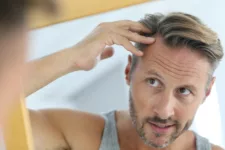Most of the patients with large balding areas and a receding hairline expect a hair transplant (click here for more details about hair transplant treatment) to cover it all. This is very understandable. They want back to the hair they had when they were young. They do not want any bald spot left after a hair transplantation. They want to feel again a thick bunch of hair on their head.
The best way is to approach this question is from a single and valid fact: Hair Transplantation is a process of Hair Redistribution. It is moving hair from one part of the scalp to another part of the scalp, i.e. the balding and receding areas.
In hair transplantation, the surgeon doesn’t create new hair, neither does he clone the hairs. Or at least, not yet. The surgeons are extracting hair follicles from the donor area of the head to the recipient part. The donor area is at the back of the head between the ears.
Why the hair follicles are extracted from the donor area?
Because the hair in this area is resistant to the male hormone Dihydrotestosterone (DHT). This hormone is the cause of hair loss. DHT is being produced by specific enzymes that convert testosterone into DHT. More than half of the men are likely to experience male pattern baldness mediated by DHT. Since the hair at the back of the head is resistant to DHT, no man loses hair in this area.

Because they are resistant to DHT, the surgeons extract these hairs and implant them to the balding and receding parts of the scalp, to increase the density in the hair in the receding parts and to cover the bald areas of the head with hair.
The donor area is approximately 1/3 of the whole scalp. So, let’s be realistic and realize that not all donor hair can be extracted to cover the balding parts. Because, what would happen? Imagine a person with full hair on the top and the front part of the scalp and at the back of the head no hair at all. Wouldn’t that look a little weird?!
Average density in the donor area is 90-120 follicular units (grafts) per square centimetre. Each follicular unit contains 1-5 hair strands. That means there are 100-250 hairs per each square centimetre. The absolute maximum grafts of hair that can be extracted from this area is one third of the total. The size of the scalp area differs from person to person. Therefore, we cannot say a scalp area has a certain amount of square centimetres. But on the average, a scalp area is around 200 square centimeter. Since the average density in the donor area is around 100 follicular units per square centimetre, the donor area contains 200*100=20,000 grafts in total. One third of all hair follicles of the donor area can be extracted without damaging the donor area. With FUE Hair Transplantation that means a donor area normally has the possibility for 6,600 grafts to be extracted without being damaged to the point of becoming a bald area itself.

Now that we know the maximum number of grafts available to be implanted to the whole balding scalp and receding hairline is limited to 6,600 grafts. That means 100% coverage or 100% density simply cannot be realized if a person who has no hair at the front, middle and top part of the scalp but only at the donor area. We refer to this stage of hair loss as Norwood 7.

Knowing this, how can a hair transplant surgeon provide the patient with a satisfying result? The surgeon should carefully design a strategy regarding to the amount of sessions the patient will need for FUE Hair Transplantation, how many follicular units should be extracted at each session and at which exact spots these grafts should be implanted.
To provide a natural result, hair transplantation starts by drawing a natural hairline, based on the person age, hair loss type and the probability for future hair loss. After that, collected grafts will be distributed, starting from the drawn hairline to the receding and balding parts. Although some patients insist on full coverage, unfortunately there is no way to create new hair follicles yet. The only option there is now, is to distribute the available extracted grafts in the recipient area in such a way that will create a nice appearance.
A patient should also be aware that not all the available grafts in the donor area can be extracted in one session. That means there is no possibility to extract 6,600 grafts and distribute them all to the balding areas in one go. In Turkey for example, one of the top destination for hair transplant, there are clinics that promise a maximum number of grafts in one session. But that does not imply that 6,600 grafts will be extracted. Theoretically it could be done, but the result would be a disaster. The back of the scalp will show empty spots and scars all over, the extracted follicles will not grow in the recipient area because the procedure took too long and they were outside the body for too long a period.
MCAN Health, in Istanbul, emphasizes that the surgeon’s planning is crucial and patients should collaborate with their surgeon to determine which strategy will be the best in their specific situation. They work with the maximum possible number of hair follicles in one session. But for them this is not the only success parameter. Success to MCAN Health is about the amount of the grafts alive and growing. Because in the end, isn’t that why you were having your hair transplant in the first place?!








